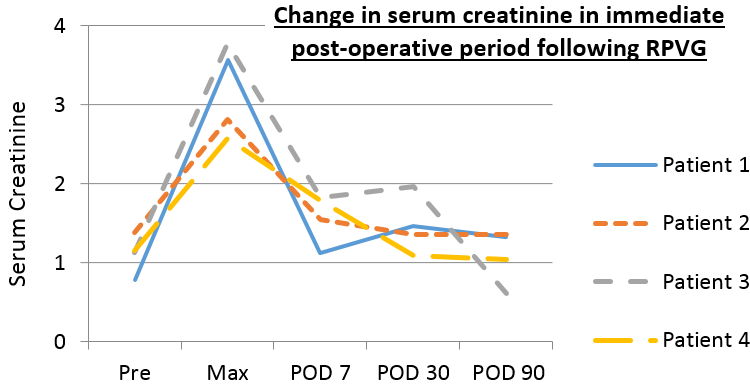Renoportal Vein Graft for Complete Portal Vein Thrombosis: A Reproducible Technique for a Challenging Problem
Baylor University Medical Center, Dallas, TX
Meeting: 2020 American Transplant Congress
Abstract number: A-117
Keywords: Graft survival, Liver transplantation, Portal veins, Surgical complications
Session Information
Session Name: Poster Session A: Liver: Portal Hypertension and Other Complications of Cirrhosis
Session Type: Poster Session
Date: Saturday, May 30, 2020
Session Time: 3:15pm-4:00pm
 Presentation Time: 3:30pm-4:00pm
Presentation Time: 3:30pm-4:00pm
Location: Virtual
*Purpose: Type-IV Yerdel portal vein thrombosis (PVT) was historically contraindicated in liver transplant due to lack of appropriate portal vein inflow. Renoportal vein graft (RPVG) has been advocated in patients with complete PVT and a splenorenal shunt (SPRS) to augment acceptable inflow to liver graft. We report our experience using RPVG for Type-IV Yerdal PVT.
*Methods: A single center prospectively maintained database was used to retrospectively review OLTx patients from 7/2016 -7/2019, identifying those with RPVG using iliac vein graft for Type-IV PVT. Primary outcomes included patient/graft survival and hospital LOS. Secondary outcomes included complications, 30-day readmission, and reoperation rate. Evolution of renal function examined sCr at pre-op, POD 7, 30, 90 as well as HD requirement. Pre-operative size of SPRS, intra-operative PV flow rate, and post operative PV velocity on doppler ultrasound were also recorded.
*Results: Type-IV Yerdel PVT OLTx RPVG (n=5) M:F (4:1), Age 56.2
In 4 pts PVT was identified pre-op and the RPVG planned once SRS confirmed. Mean size of SPRS was 17.2mm. Mean MELD 26.5. Mean intra-op PV flow measured 1089ml/min and POD 1 DUS PV velocity 75.6cm/s. Mean LOS 7.8 day and 30-day readmission rate of 50%. All patients were alive with functioning graft at last follow-up (33, 10, 8, and 3 months respectively). Complications included fascial dehiscence (n=1), reoperation (n=2) and persistent ascites requiring IR stenting (n=2). Serum Cr returned to baseline by POD 30 in all four patients with no requirement of dialysis.
In one patient Type-IV PVT was identified intraoperatively and RPVG was used as a salvage approach. Postoperative PV flow was poor with velocity 16.8 cm/s on doppler ultrasound. Patient expired on post operative day 3.
*Conclusions: This report reiterates prior studies that a renoportal vein graft can facilitate acceptable portal flow in patients with Type IV Yerdel portal vein thrombosis. Recipient selection depends upon the presence of an acceptable sized splenorenal shunt. Despite outflow modification of the left kidney, our patients had a return of renal function to previous baseline. However, recurrent ascites was appreciated in two patients and has been a well document complication of this technique. Nevertheless, the use of a renoportal vein graft can allow patients to be considered for transplant who were previously deemed unacceptable.
To cite this abstract in AMA style:
Mehta P, Black M, Fernandez H, Bayer J, Gupta A, Wall A, Martinez E, Onaca N, Ruiz R, Testa G, Mckenna GJ. Renoportal Vein Graft for Complete Portal Vein Thrombosis: A Reproducible Technique for a Challenging Problem [abstract]. Am J Transplant. 2020; 20 (suppl 3). https://atcmeetingabstracts.com/abstract/renoportal-vein-graft-for-complete-portal-vein-thrombosis-a-reproducible-technique-for-a-challenging-problem/. Accessed December 18, 2025.« Back to 2020 American Transplant Congress

